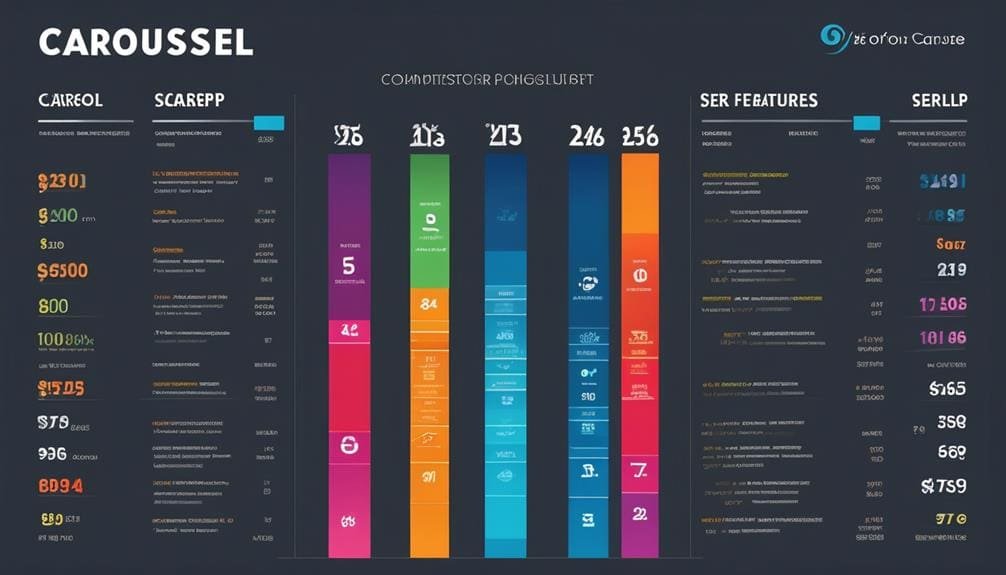6 Best Strategies for Carousel SERP Feature Targeting
March 17, 2024 | by Jacob Cavazos

What if you could consistently land your website in the prized carousel SERP feature? Imagine the impact on your traffic and click-through rates. With the constantly evolving landscape of search engine result pages, it’s crucial to adapt and optimize your strategies for this prominent feature. In this discussion, we’ll explore the six best strategies for targeting the carousel SERP feature, from understanding its nuances to leveraging visual content and conducting thorough competitor analysis. These actionable tactics are designed to help you elevate your website’s visibility and drive valuable organic traffic. So, are you ready to take your SERP game to the next level?
Understanding Carousel SERP Feature
To effectively understand the Carousel SERP Feature, we must grasp its function as a dynamic display of scrollable content at the top of search results, providing users with a visually engaging means to explore diverse content options related to their search queries. This feature, a prominent component of Google SERP features, offers an interactive and visually appealing format for users to discover relevant information such as recipes, movies, products, and places. Understanding the Carousel SERP Feature is crucial for optimizing your content strategy for Google. By leveraging structured data markup and optimizing titles, you can enhance the visibility of your content and increase the likelihood of appearing in the Carousel SERP Feature.
When targeting the Carousel SERP Feature, it’s essential to focus on providing high-quality, visually engaging images or videos, along with relevant metadata. Additionally, ensuring mobile responsiveness is vital for delivering the best user experience. By tailoring your content to meet the requirements of the Carousel SERP Feature, such as providing concise and relevant information, you can improve your chances of being featured in video carousels, product carousels, and other scrollable content formats. This understanding of the Carousel SERP Feature is crucial for optimizing your content strategy and increasing your visibility on the search engine results page.
Keyword Research for Carousel SERP
As we delve into the topic of keyword research for Carousel SERP, it’s crucial to understand the significance of search intent analysis, the value of long-tail keywords, and the insights derived from user behavior. By focusing on user intent and behavior, we can identify keywords that are likely to trigger Carousel SERP features. Utilizing keyword research tools to pinpoint high-volume, relevant keywords and prioritizing long-tail and question-based queries can optimize our content for Carousel SERP visibility. Analyzing competitor content and considering user engagement and search intent will inform our keyword targeting strategy, ensuring valuable and concise information that aligns with Carousel SERP content requirements.
Search Intent Analysis
Analyzing search intent is crucial for identifying the most relevant keywords to target to optimize content for Carousel SERP features. Understanding the search intent behind a search query is essential for aligning content with the needs of the target audience. By analyzing search intent, we can tailor our keyword research to focus on terms that align with the specific informational, navigational, transactional, or commercial investigation intent behind the search. This approach helps in optimizing content not just for traditional organic search but also for featured snippets and Carousel SERP features. Leveraging Google’s understanding of search intent through SEO strategies can significantly enhance online presence and visibility. By incorporating search intent analysis into keyword research, we can create more targeted and effective content that meets the needs of our audience and aligns with Google’s evolving SERP features.
Long-Tail Keywords
Understanding the search intent behind a query guides our strategy for targeting long-tail keywords to optimize content for Carousel SERP features. Long-tail keywords, consisting of longer and more specific search queries, play a crucial role in driving organic traffic and improving your chances of appearing in featured snippets within the carousel. By optimizing your content around these target keywords and providing users with valuable, detailed information that directly addresses their related questions, you can enhance your visibility in carousel SERP features. Long-tail keyword research for carousel SERP involves identifying niche queries that align with user intent and crafting content tailored to these specific needs. Leveraging long-tail keywords not only helps in standing out from traditional search results but also in capturing a more focused and conversion-oriented audience.
User Behavior Insights
By examining user behavior insights, we can uncover valuable data that informs our keyword research strategy for targeting carousel SERP features. Understanding how users interact with search results and what type of content they engage with provides us with crucial information for optimizing our content to appear in the carousel. Here’s a look at some user behavior insights that can guide our keyword research strategy:
| User Behavior Insights | Impact on Keyword Research |
|---|---|
| Popular Search Queries | Identify trending topics |
| Content Preferences | Tailor content to user preferences |
| Search Intent | Inform content creation |
| Long-Tail Keywords | Uncover specific search phrases |
Content Optimization for Carousel SERP
To achieve optimal content optimization for Carousel SERP, we focus on crafting engaging and relevant information that aligns with user intent and provides actionable value. When it comes to SEO content, structuring your content for Carousel SERP involves incorporating rich snippets, which are additional pieces of information displayed alongside the URL in the search results. These rich results can include review ratings, prices, and availability, making your content more appealing and informative to users. Furthermore, optimizing meta tags, headings, and descriptions on landing pages can significantly impact the likelihood of your content being featured in the Carousel SERP.
For local businesses, leveraging Google My Business is crucial for Carousel SERP visibility. Ensuring that your business information is accurate, up-to-date, and optimized for local SEO can enhance your chances of appearing in the local Carousel results. It’s essential to understand user behavior and intent in your target market to tailor your content to their needs. By continuously monitoring and adapting your content strategy based on user insights and search trends, you can improve your visibility in Carousel SERP features on Google Search.
Local SEO for Carousel SERP

Leveraging local SEO strategies is essential for maximizing visibility in the Carousel SERP feature, requiring accurate NAP information, positive reviews, location-specific keywords, structured data markup, and proactive Google My Business management. Implementing these strategies can significantly enhance the chances of appearing in the local pack and carousel results, increasing the visibility of your content to local audiences. To illustrate the key components of local SEO for carousel SERP, consider the following table:
| Local SEO Strategies for Carousel SERP |
|---|
| 1. Accurate NAP Information |
| 2. Positive Reviews and Ratings |
| 3. Location-Specific Keywords |
| 4. Structured Data Markup |
These strategies play a crucial role in improving the visibility of your business in the local carousel results, ultimately driving more organic traffic and potential customers to your website. Additionally, incorporating FAQs, videos, and snippets optimized for local search can further enhance your presence in the carousel SERP, increasing the likelihood of appearing at the top of the search results. By focusing on these local SEO tactics, businesses can effectively position themselves for success in the competitive landscape of local search.
Visual Content for Carousel SERP
Utilizing high-quality visual content such as images, videos, or infographics is essential for maximizing visibility and engagement in the Carousel SERP feature. Optimizing images with descriptive file names, alt text, and relevant keywords is crucial for increasing the likelihood of being featured in the carousel. Consistency in image dimensions and aspect ratios is important for a visually appealing display in the SERP.
When creating visual content for carousel SERP, it’s vital to consider the user intent and incorporate relevant keywords and metadata to enhance its relevance. This can improve the chances of inclusion in the carousel SERP and drive organic traffic to the website.
Incorporating visual content that aligns with the search intent and provides additional information can improve the chances of being featured in the carousel. It’s also important to ensure that the visual content is optimized for mobile devices, as a significant portion of searches occur on mobile platforms.
Competitor Analysis for Carousel SERP

Analyzing competitors’ performance in the Carousel SERP can provide valuable insights for optimizing our strategy and increasing visibility. Understanding how competitors appear in the Carousel SERP can help us identify best practices and potential opportunities for improvement. Here are some key aspects to consider when conducting competitor analysis for Carousel SERP:
- Image Selection: Evaluate the types of images your competitors are using in the Carousel SERP. Look for patterns in image styles, formats, and subjects to understand what resonates with users.
- Descriptive Alt Text: Assess how competitors are utilizing descriptive alt text for their images. This can provide insights into their approach to making images accessible and understandable to search engines.
- People Also Ask (PAA) and Featured Snippets: Study how competitors are addressing common questions and providing information in the PAA and featured snippets. This can help identify content gaps and potential opportunities for capturing these positions.
- Technical SEO: Analyze competitors’ technical SEO efforts, such as site speed, mobile-friendliness, and structured data markup for images. Understanding their technical strengths can inform our technical optimization strategies.
Frequently Asked Questions
How Do I Optimize My SERP Features?
We optimize SERP features by targeting featured snippets, local SEO, video, image alt text, voice search, mobile responsiveness, rich snippets, schema markup, the knowledge graph, and click-through rate. This drives visibility and engagement.
How Do I Target Google SERP Features?
Targeting Google SERP features requires optimizing for keywords, creating engaging visual content, and prioritizing mobile optimization. Local businesses benefit from rich snippets and schema markup, while voice search and featured snippets enhance user engagement and brand authority.
What Is the Carousel Feature in SERP?
We understand the carousel feature in SERP as a horizontal scrolling list of items, showcasing various options related to search queries. It enhances user engagement, particularly on mobile, and optimizing content for it impacts SEO.
How Can I Improve My SERP Position?
Improving our SERP position requires strategic keyword targeting, optimizing content, and enhancing user engagement. We prioritize mobile responsiveness, site speed, and local SEO for organic traffic growth. Our data-driven approach ensures actionable and engaging results.
RELATED POSTS
View all



